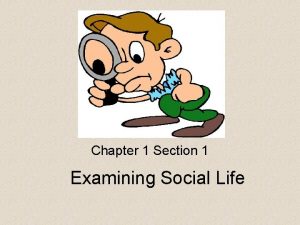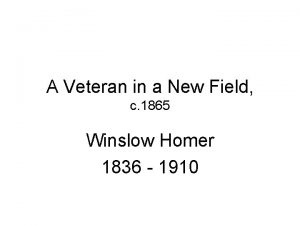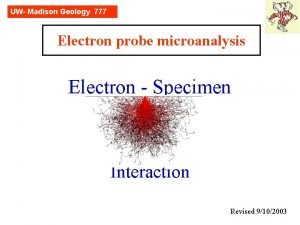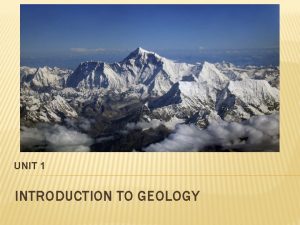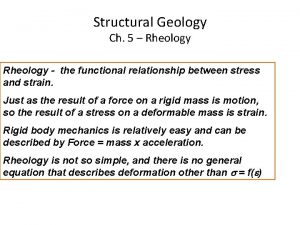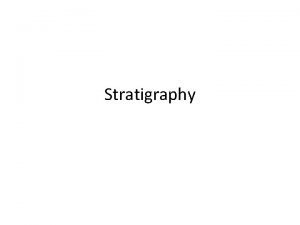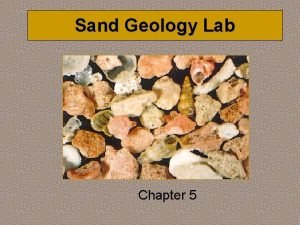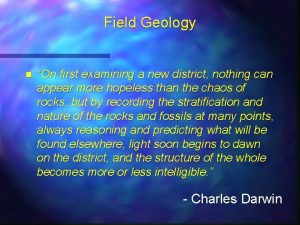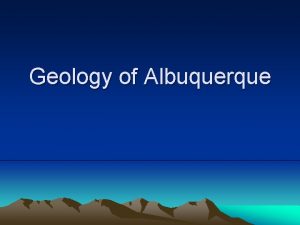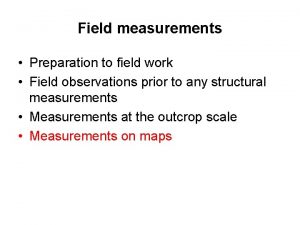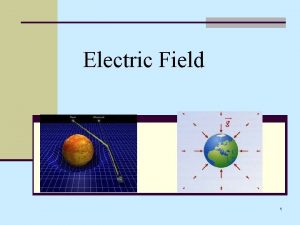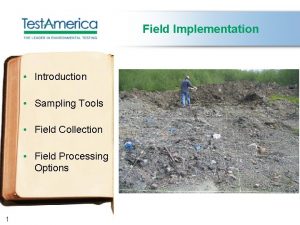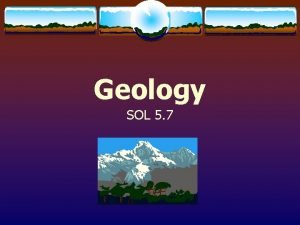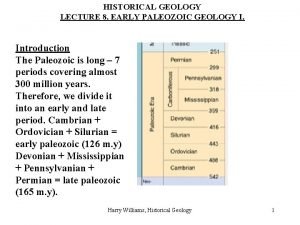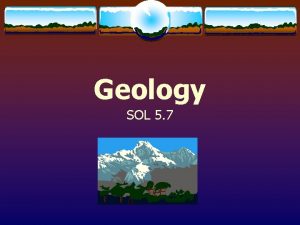Field Geology n On first examining a new






















- Slides: 22

Field Geology n “On first examining a new district, nothing can appear more hopeless than the chaos of rocks; but by recording the stratification and nature of the rocks and fossils at many points, always reasoning and predicting what will be found elsewhere, light soon begins to dawn on the district, and the structure of the whole becomes more or less intelligible. ” - Charles Darwin

What is a Geologic Map? n Geologic maps constitute a fundamental and objective scientific foundation on which land-use, water-use, and resource-use decisions are based. A geologic map records the distribution of rock and sediment materials at and near the land surface, and is the best science product to display the information that decision makers need to identify and protect valuable resources, avoid risks from natural hazards, and make wise use of our land.

n The geologic mapper strives to understand the composition and structure of geologic materials at the Earth's surface and at depth, and to depict observations and interpretations on maps using symbols and colors.

Drawing Map Contacts n Three fundamental types of contacts: Depostional, Fault and Intrusive. l l Solid lines are definite contacts, dashed lines are approximate contacts, dotted lines are concealed contacts. Faults are drawn in heavier lines and have associated kinematic sympols.

Drawing Map Contacts Continued n n Discordant intrusive rock bodies have irregular contacts. Tabular rock bodies have planar or curviplanar contacts. Faults behave this way too. l l l Most depositional contacts Dikes and sills When flat lying these contacts follow topography When vertical they are straight When dipping they follow the rule of Vs. These can be predicted and logically projected based on topographic expression, vegetation, etc. – i. e. they do not rapidly change orientation

Objectives of Mapping Accurately show surface distribution of bedrock units (i. e. contacts) n Present sufficient structural data to interpret the three-dimensional subsurface geometry of rock units n You can’t have too much structure data! n

Mapping Procedures n Keep field and office maps l n Your office map is your insurance policy Do all mapping in the field l l Draw all contacts in the field Color units in the field Plot strikes and dips in the field Why? – – – Allows you to see inconsistencies and plan a mapping strategy Field maps will be collected and graded without warning

Mapping Procedures n Keep track of your location at all times l l n Know the contour interval and scale of the map Use terrain recognition, triangulation or any other method to accurately locate yourself Keep a record of your field stations l Identify the location of each station in your notebook and on your map.

Drawing Map Contacts n Use different lines for different types of contacts l n Solid, dashed, and dotted all indicate something different Tabular rock bodies have planar or curviplanar contacts l l l Most depositional contacts Dikes and sills These can be predicted and logically projected based on topographic expression, vegetation, etc. – i. e. they do not rapidly change orientation

Drawing Map Contacts n Dipping beds: Obey the Rule of V’s l Contacts will commonly “V” in the direction of dip – One exception to this rule: – when bedding dips less steeply, and in the same direction as the surface slope, V points up-dip n Contacts will parallel strike ridges and hogbacks l n Contacts commonly occur at the base of a dip or an anti-dip slope Contacts may be zig-zag or diamond shaped along flatirons

Rule of V’s

Rule of V’s

Flatirons

Special Map Units n Qal – Quaternary alluvium l l n Qls – Quaternary landslide l l n Refers to Recent stream deposits Generally flat-lying…. . gently sloping down stream Found where streams have low gradients Generally thin for mountain streams. Refers to recent landslide deposits Often indicated by convex down-hill distortions of elsewhere parallel topographic contours Bedrock contacts should be dotted as concealed beneath these deposits

Coloring Your Map n Do this in the field l n Color lightly – you’re going to erase a lot Choose visually appealing colors l l USGS has selected colors for different time periods Reserve yellows and oranges for Qal and Qls

Official USGS Map Colors Quaternary orange Tertiary yellow ocher Cretaceous olive-green Jurassic blue-green Triassic bluish gray-green Permian blue Pennsylvanian gray Mississippian blue-violet Devonian heliotrope Silurian purple Ordovician red-violet Cambrian brick red Precambrian pink or gray-brown

Structural Data n Be careful to select a good spot to measure l l n No slump blocks No cross-bedding surfaces Collect enough data to accurately represent the structural geometry of the area l l l Depends on structural complexity of area Attempt uniform distribution of data when possible Gather more data along your line of cross section.

Good Field Sketches Result in a Better Map n Sketch out complicated map patterns l l n Helps you recognize problems Develop multiple working hypotheses for how units are arranged Sketch out simplified cross sections l l l Helps you recognize poor surface contact placement Helps you identify faults and determine their geometry and sense of slip Helps you when you later draw your final cross section

Variables Affecting Map Patterns Formation thickness n Formation dip n Surface topography n Map patterns are predictable when units are uniformly thick and homoclinally dipping

Topography and Map Patterns

Testing for Mapping Accuracy Don’t forget thickness, depth, and three-point problems will help! n Calculate strike and dip from your map pattern n l n Construct the outcrop pattern in areas that are poorly constrained l n It should match the measured value Requires uniform dips and thicknesses Calculate formation thickness from your map pattern l It should be in the range we established, unless noted otherwise.

What you need for tomorrow n n n n A positive attitude Colored pencils Map (something to cover it in a rainstorm) Clipboard Protractor/Ruler Compass Radio – one per group Rain gear
 Examining social life
Examining social life Csi handwriting analysis
Csi handwriting analysis Relationship of sociology with other social sciences
Relationship of sociology with other social sciences Data preparing exploring examining and displaying
Data preparing exploring examining and displaying Examining social life practice
Examining social life practice Acquiring spiritual knowledge part 2
Acquiring spiritual knowledge part 2 What conclusions can you make from examining the geochart?
What conclusions can you make from examining the geochart? Gauss law of magnetism
Gauss law of magnetism Individual differences in second language learning
Individual differences in second language learning Field dependent vs field independent
Field dependent vs field independent Electric field and magnetic field difference
Electric field and magnetic field difference Waveguide cutoff frequency
Waveguide cutoff frequency Data types and field properties
Data types and field properties Field dependent definition
Field dependent definition Magnetic field
Magnetic field Weyth
Weyth What is geology
What is geology Geology
Geology What is geology?
What is geology? Structural geology
Structural geology Stratigraphy
Stratigraphy Geology lecture series
Geology lecture series Grain size card
Grain size card




